Jul 12, 2010
The Venusian Atmosphere and “Runway Planet Warming”
By Jules Kalbfeld
The planet Venus has entered the carbon dioxide (CO2)/ global warming discussion because its atmosphere is 96.5% (965,000 ppm.) CO2 and its surface temperature is higher than that of Mercury which is closer to the Sun. Since radiant energy varies inversely as the square of the distance (S) traveled from its source (E~1/S2) and Mercury’s distance from the Sun is about 1/2 that of Venus, Mercury should be exposed to 4 times the Solar energy that Venus is and should experience markedly higher surface temperatures than Venus. Venus is also about 2/3 the distance from the Sun as the Earth is. Using that same relationship “E~1/S2”, the surface temperature of Venus would be expected to be about 2.25 times that of the Earth. However, the average temperature of Venus’s surface is actually about 20 times that of the Earth’s surface.
E = 1/S squared
For Venus/Mercury E = 1/(1/2)2 = 1/(1/4) = 4/1 = 4
For Earth/ Venus E = 1/(2/3)2 = 1/(4/9) = 9/4 = 2.25
These factors have been combined to infer that Venusian “runaway” global warming is primarily induced by the high concentration of CO2 in its atmosphere. This paper is intended to focus on isolated aspects of CO2’s contribution to Venus’s global warming and to thereby promote a discussion of its true influence on Venus’s global temperature.

A detailed analysis of the venusian atmosphere is conducted with results from the Magellan and Venus Explorer probes.
CONCLUSION
Venus is the hottest planet in the Solar system. Venus is hotter than Mercury which is 1/2 of it’s distance from the Sun. Venus’s atmosphere has 93 times the total mass of the Earth’s atmosphere and is 97.7 mass% CO2. The total mass of CO2 in Venus’s atmosphere is 152,451 times the total mass of CO2 found in the Earth’s atmosphere and the mass fraction of CO2 in Venus’s atmosphere is 1,639 times its mass fraction in Earth’s atmosphere. These facts have led to the generally accepted conclusion that CO2 has caused “run away” global warming of Venus and its atmosphere. This conclusion been extrapolated to reenforce the notion of CO2 induced global warming on Earth.
The preceding simple “thought experiment” was designed to explore some possible thermal consequences of an Earth equivalent (in composition) atmosphere on Venus (AIRv) at a pressure equal to Earth’s sea level atmospheric pressure. The results of this “experiment” illustrate that such an atmosphere on Venus would most likely have the same temperature (69 C) as was measured in Venus’s atmosphere at Earth’s sea level pressure by the Magellan and Venus Explorer space probes.
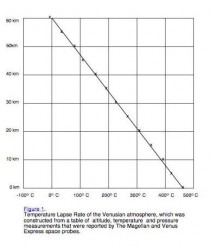
A table of Venusian atmospheric altitude, temperature and pressure data that was collected by the Magellan and Venus Express space probes was used to construct a graph (Fig. 1) depicting the (reverse) temperature lapse rate for the Venusian atmosphere from an altitude of 60 km down to it’s surface. That graph was a straight line, with no deviations, indicating that there were no layers within Venusʼ atmosphere that had trapped and stored reradiated heat.
This study, though hypothetical in nature, tends to question the role of CO2 in the “run away” global warming of Venus and it’s CO2 rich atmosphere. It also tends to minimize the notion of CO2 acting as a green house gas in general.
AUTHOR’S NOTE:
Other factors, such as axial tilt, sidereal rotation period, large variations in wind velocities, etc. can potentially effect the temperature of Venus and it’s atmosphere. However, the intention of this paper is to totally focus on CO2 and it’s contribution to the temperature of Venus and it’s atmosphere. J.K.
Jul 09, 2010
Heat islands: Cities heat quickly, cool slowly
By Deepti Hajela
UPDATE: See this analysis of heat wave days and death trends for 40 major cities. It shows both declining for the periods 1975 - 2004 from 1975 - 1995 here. See further comments after post below.
NEW YORK (AP)—Hot town, summer in the city? No kidding.
The high temperatures blanketing the Northeast and mid-Atlantic regions of the country are making many people miserable, but those in New York City, Philadelphia and other dense, built-up areas are getting hit with the heat in a way their counterparts in suburbs and rural areas aren’t.
Cities absorb more solar energy during the day and are slower to release it after the sun sets, making for uncomfortable nights and no real relief from the heat. And because they haven’t cooled down as much overnight, mornings are warmer and the thermometer goes right back up when the sun starts beating down the next day.
Scientists have known for years about so-called heat islands, urban areas that are hotter than the less-developed areas around them. Cities are just “not well designed to release that summertime heat,” said William Solecki, geography professor at Hunter College and director of the City University of New York’s Institute for Sustainable Cities.
The lack of nighttime relief can make the daytime high temperatures even more difficult for people to take as the days pass and the heat continues, he said.
That’s “where you start to have real problems, if your body’s not cooling down,” Solecki said. “You’re not getting that break.”
Deaths blamed on the heat included a 92-year-old Philadelphia woman whose body was found Monday and a homeless woman found lying next to a car Sunday in suburban Detroit.
The heat-islands effect is significant in the East because “we have a large population living in heavily built-up areas with lots of concrete and lots of steel, good absorbers of heat,” National Weather Service spokesman Sean Potter said.
And there’s nothing like the extreme heat of the past couple of days to make it obvious to everyone.
On Tuesday, the temperature hit 103 degrees in New York City and 102 in Philadelphia, soared past the century mark in Boston, Washington, D.C., and Newark, N.J., and broke records in Providence, R.I., and Hartford, Conn.
The heat-island effect occurs because cities, with their numerous building surfaces and paved roads, absorb more of the solar energy coming from the sun during the day than places that are less built up. At night, those types of surfaces don’t release that accumulated energy as quickly.
Cities also are very dry places, due to the lack of greenery and vegetation that could help bring moisture into the area and keep temperatures down, said Stuart Gaffin, an associate research scientist at Columbia University who focuses on urban climatology and environment.
All that combines to make cities risker places for people during times of extreme heat, he said. “For me,” Gaffin said, “this is the scariest kind of weather.”
Read more here.
The heat was concentrated in the coastal plain and urban areas near the coast and enhanced by downslope compressional warming. Usually the 100F days for the big cities of the northeast come with a northwest wind coming downslope from the higher elevations. This adds 5F or so to the temperature. urban heat islands hold the heat at night. NOAA (thanks to Tom Peterson) and CRU (thanks to Phil Jones and David Parker) denied the contamination effect of urban heat island (UHI) and make no corrections for UHI in their data bases. NOAA USHCN version 1 had such a correction when first implemented in 1990 based on work by Tom Karl (1988). They removed it in version 2 in 2007. NASA GISS to their credit does an urbanization assessment but its corrrective effect is offset by homogenization in the United States and bad metadata globally. They utilize night lights in North America to determine urban, suburban and rural. Globally they had used population but McIntyre showed, their metadata that was used to determine urban vs rural was so bad, they adjusted urban areas warmer as often as cooler. They are moving to night lights globally but the homogenization factor still remains an issue. See more here.
Also predictably, they rolled out their nonsense projections about increasing heat waves in the future today here. Though impressive in the northeast, the heat is not unprecedented and in fact it was moderate in much of the country (typically very warm and humid but not heat waves). Some of the loudest voices are the same clowns that argued that the extreme cold and snow this past winter was weather not climate and should be ignored.
See how the last decade has seen the least number of heat waves since the 1800s in the US and Canada (US below and enlarged here, US and Canada enlarged here).
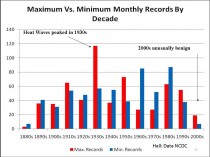
Why we continue to waste our precious research dollars on these useless models is beyond me. Basing policy on them is sheer folly.
Jul 08, 2010
Climategate: reinstating Phil Jones is good news - the CRU brand remains toxic
By Gerald Warner
"Move along now, please… Nothing to see here...” was the predictable burden of Sir Muir Russell’s investigation into Climategate. Are we surprised? Any other conclusion would have made world headlines as a first for the climate change establishment. This is the third Climategate whitewash job and it would be tempting to see it as just as futile as its predecessors. That, however, would be to underrate its value to the sceptic cause, which is considerable.
This is because Russell’s “Not Guilty” verdict has been seized upon as an excuse to reinstate Phil Jones at the University of East Anglia CRU, this time as Director of Research. That is very good news. It spells out to the world that the climate clique looks after its own; that there is no more a culture of accountability and job forfeiture for controversial conduct in AGW circles than there is in parliamentary ones; that it is business as usual for Phil and his merry men. Or, to put it more bluntly, the brand remains toxic.

Apart from Michael “Hockeystick” Mann, there is no name more calculated to provoke cynical smiles in every inhabited quarter of the globe than that of Phil Jones. The dogs in the street in Ulan Bator know that he and his cronies defied FOI requests and asked for e-mails to be deleted and that people only do that if they have something to hide. Every time some UN-compliant government or carbon trading interest group tries to scare the populace witless with scorched-earth predictions of imminent climate disaster and cites research from the East Anglia CRU - of which Phil Jones is Director of Research - it will provoke instant scepticism.
As I pointed out earlier this week, the AGW lobby has recently shown signs of belatedly getting its PR act together, of assuming a false humility, of being less dogmatic, in an effort to win round public opinion. It is an attempt to turn over a new leaf - on the Dave Cameron model, to detoxify the brand. It is, of course, a ploy to recover lost credibility and impose upon the public more effectively. Putting Phil Jones back at the centre of the picture completely wrecks that rehabilitation scheme. It is as if Dave appointed Lady Thatcher to oversee his “compassionate Conservatism” agenda.
The problem for the more sophisticated warmist propagandists is that, on this occasion, the attempt to construct a Cameron-style “modernised” climate scare party collided with the primeval instinct of the British academic and public-sector establishment to protect its own. It shares with the Spanish Legion the principle of never abandoning its wounded. None of our boys will ever be taken out by the sceptics, is the rule, no matter how badly they goof up.
So, this is an important and encouraging development for everybody dedicated to blowing the AGW scam out of the water. It means one of the principal pillars of the IPCC that might have been cosmetically repaired now remains irretrievably compromised. The next few years will be critical for the survival of the AGW superstition: it is now, partly due to Climategate and partly to the global recession, fighting for survival. This latest blunder significantly lessens its prospects of pulling through. A big thank you to Professor Edward Acton and the climate establishment at the University of East Anglia and elsewhere, without whose purblind sense of entitlement the eventual overthrow of this false orthodoxy might not have been possible.
See post here.
Jul 08, 2010
What’s It Mean For The Bloke On The Bus?
By Andrew Orlowski, the Register
The University of East Anglia’s enquiry into the conduct of its own staff at its Climatic Research Unit has highlighted criticisms of the department and staff conduct - but clears the path for the individuals concerned to carry on.
The CRU played an important role in writing the UN’s IPCC summaries on climate science, so the issue is far from a parochial one. The most serious charge is poor communication; Sir Muir Russell even calls for “a concerted and sustained campaign to win hearts and minds” to restore confidence in the team’s work.
Russell was appointed by the institution to investigate an archive of source code and emails that leaked onto the internet last November. The source code is not addressed at all. His report suggests that the problems were of the academics’ own making, stating that they were “united in defence against criticism”. Yet the enquiry found that despite emails promising to “redefine” the peer review publication process, and put pressure on journal editors, staff were not guilty of subverting the IPCC process, and their “rigour” and “honesty” were beyond question.
Leading academics were called for written and oral evidence before the Russell enquiry, and in many cases the report accepts their account of events. For example, wearing their IPCC hats, the academics are cleared of excluding critical evidence, and yet bending the rules to include supporting studies. To reach this particular conclusion, for example, the report finds a criterion: a “consistence of view” with earlier work… by the academics in question.
Despite the gentlemanly and clubbable tone, the report nevertheless has deep systemic criticism of the institution and the team’s processes. UEA “fell badly short of its scientific and public obligations”, according to one review panel member, Lancet editor Richard Horton.
It criticises the team’s decision to curtail a temperature reconstruction at 1960, and splice on an instrumental temperature record, without explanation, noting:
“The figure supplied for the WMO Report was misleading in not describing that one of the series was truncated post 1960 for the figure, and in not being clear on the fact that proxy and instrumental data were spliced together. We do not find that it is misleading to curtail reconstructions at some point per se, or to splice data.”
There’s a selective approach to criticism of scientific techniques - officially, Muir Russell says it doesn’t examine the validity of scientific arguments. But as you can see, in places, it does. On the issue of the Yamal reconstruction, CRU is cleared but the related issues of basing the reconstruction on a limited sample of proxies, and using techniques which exaggerate and validate outliers (basically, one tree) is not addressed.
FOIA
On compliance with Freedom of Information requests, the enquiry found the CRU team evasive, and “found a tendency to answer the wrong question or to give a partial answer”. They also found “a clear incitement to delete e-mails, although we have seen no evidence of any attempt to delete information in respect of a request already made”. (Jones had told a US academic that “I think I’ll delete the file rather than send to anyone” and requesting deletions from other staff.)
The defensiveness “set the stage”, says Russell, for the barrage of FOIA requests last year, but “clear and early action would likely have prevented much subsequent grief”. It adds that “CRU helped create the conditions for this campaign by being unhelpful in its earlier responses”.
The institution itself had failed to anticipate the new FOIA regime, and let the academics run amok. Strangely it calls for “a concerted and sustained campaign to win hearts and minds” to restore confidence.
On information handling, the report “highlighted significant problems in the areas of: imbalance of authority; lack of effective challenge at appeal; over dependence on single individuals; inadequate escalation processes and limited strategic oversight.”
The panel avoided examining the scientific work of the CRU Team - as have the two other reviews of the leaked archive by Lord Oxburgh, and the Commons Select Committee on science. If the academics had used bats’ wings or tea leaves to create temperature reconstructions, that wasn’t a matter for any of the panels to judge. And this is undoubtedly a shortcoming. The voter is entitled to see the evidence and understand the arguments that may answer the question: “Is this climate thing anything to worry about?”
It’s worth taking a step back from the details of Climategate to understand the background to the enquiries. By understanding what the CRU academics do, we can judge how important the criticism of them may be - or not.
What did the CRU crew do?
The Climatic Research Unit is one part of the picture, an important one, but not at the heart of climate theory. They’re not physicists, and they don’t do the physics upon which competing explanations of how the climate works stand or fall, once measured against observation. So in that sense, ‘Climategate’ isn’t a ‘Climategate’ - it isn’t a Scopes Trial of the global warming theory.
But CRU does two important things that shape our understanding of the present and the past. CRU is one of a small number of bodies that calculates global temperature readings (of where we are today), and is probably the pre-eminent body that performs historical temperature reconstructions, quite literally writing or re-writing history. And its importance is magnified since the leading academics are also lead authors of the UN’s IPCC reports - the vast volumes policy makers like to cite as their scientific justification, but rarely read.
In the absence of a strong physics story, this temperature work became hotly contested. The biggest bone of contention is whether modern, post-1850 warming is anomalous. If it is, then the likelihood that we were in strange and uncharted territory is much greater. If it isn’t, then consequently, the need for “urgent political action” - involving sweeping changes to industrial policy and social policy - became weaker.
The father of modern climatology, HH Lamb, founded CRU in 1972, and the building the academics work in takes his name. When Lamb contributed to the first IPCC report in 1990 the historical temperature record looked like this (enlarged here).
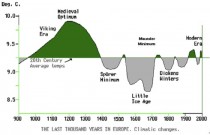
Lamb’s temperature graph, featured in the first IPCC report in 1990
By 2001, it looked like this (enlarged here).
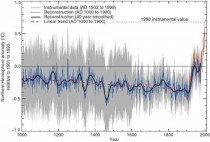
Without the error bars (grey), the Medieval Warm Period disappears Source: IPCC TAR 2001
What Climategate is largely about, then, is whether the academics were justified in making that Medieval Warm Period disappear.
Unfortunately, none of the three ‘independent’ reviews have grappled with this. The absence of anomalous warming doesn’t, as some skeptics say, make the problem go away. But it takes the issue back onto the blackboard, back into realms of the potential threats. It certainly removes much of the impetus for a sweeping and urgent political program of mitigation.
Yet in the academics’ own words, we learn that the recent burst of warming, while real, is far from unusual.
One of the leading CRU academics, Keith Briffa, wrote that:
“I know there is pressure to present a nice tidy story as regards ‘apparent unprecedented warming in a thousand years or more in the proxy data’ but in reality the situation is not quite so simple. We don’t have a lot of proxies that come right up to date and those that do (at least a significant number of tree proxies ) some unexpected changes in response that do not match the recent warming. I do not think it wise that this issue be ignored in the chapter…
“For the record, I do believe that the proxy data do show unusually warm conditions in recent decades. I am not sure that this unusual warming is so clear in the summer responsive data. I believe that the recent warmth was probably matched about 1000 years ago.”
In an interview in February, CRU director Phil Jones agrees that recent warming isn’t statistically significant, and is matched by previous periods in the instrumental record - such as 1860 to 1880.
The sensible end of the climate debate hinges on how much of a lasting consequence an increase in CO2 has on the climate system. Some prominent scientists who as recently as 2001 were lead authors for the IPCC don’t dispute there’s an effect, but maintain that once it’s worked itself out, the effect is small.
Proponents of large positive CO2 feedbacks have pointed to various ‘fingerprints’ which are absent, or refuse to manifest themselves. Greenhouse gas warming was supposed to create a telltale warming of the troposphere, but instrumental readings show no such evidence. More recently, they have posited that CO2 must have caused warming, but this is still trapped in the oceans. This “missing heat” has yet to be found, and in the Climategate archive we find US scientist Kevin Trenberth expressing frustration: “The fact is that we can’t account for the lack of warming at the moment and it is a travesty that we can’t,” adding that “we can’t definitively explain why surface temperatures have gone down in the last few years. That’s a travesty!”
For Trenberth, if we had better instruments, we’d find the heat. For skeptics, the heat might not be there.
By the mid-2000s the issue had become so politicised the academics were acting like a “priesthood”, in the words of environmental writer Fred Pearce, no friend of the skeptics. As Jones wrote in an email: “Many of us in the paleo field get requests from skeptics (mainly a guy called Steve McIntyre in Canada) asking us for series. Mike and I are not sending anything, partly because we don’t have some of the series he wants, also partly as we’ve got the data through contacts like you, but mostly because he’ll distort and misuse them.”
In a sense the CRU team are carrying the can for the physicists’ failure to do the science. See full post here.
Jul 08, 2010
The Muir Russell CRU Apologia is out
By Anthony Watts
The Muir Russell Report is out. Read here in PDF. Unfortunately Russell is another apologist who doesn’t ask relevant questions of both sides, only one side. Even BBC now thinks the CRU wears a halo: click for full screencap Compare that to:
CRU’s Dr. Phil Jones’s response of 21/02/2005 to Warwick Hughes’s request for Jones’s raw climate data:
“Even if WMO agrees, I will still not pass on the data. We have 25 or so years invested in the work. Why should I make the data available to you, when your aim is to try and find something wrong with it.”
Here’s some comments around the web, link to the report follows:
Steve McIntyre:
I guess the main question coming out of the Muir Russell report is when is he going to be appointed to the House of Lords and his choice of appelation. Lord Muir of Holyrood?
They adopted a unique inquiry process in which they interviewed only one side - CRU. As a result, the report is heavily weighted towards CRU apologia - a not unexpected result given that the writing team came from Geoffrey Boulton’s Royal Society of Edinburgh.
The issue here is whether Wahl and Briffa violated IPCC rules. Asking Overpeck about this is not very helpful since Overpeck is hardly impartial. Muir Russell had to examine what Wahl and Briffa actually did and then examine the conduct against actual IPCC rules, not after-the-fact opinions by parties to the conduct.
The findings of the Fred Pearce Inquiry on this point stand:
These back channel communications between the paper’s authors [Wahl] and IPCC authors [Briffa], including early versions of the paper, seemed a direct subversion of the spirit of openness intended when the IPCC decided to put its internal reviews online.
More from Steve:
Muir Russell said that it wasn’t the scientists weren’t to blame for defamatory language in emails, e.g. calling “frauds”, “fraudit”, “bozos”, “morons” and so on. It was Microsoft’s fault.
They asked:
Indeed, some submissions have characterised them as ‘unprofessional’, or as evidence of CRU’s contribution to a ‘poisoned atmosphere’ in climate science.
Muir Russell blamed email itself for the language:
14. Finding: The extreme modes of expression used in many e-mails are characteristic of the medium. Crucially, the e-mails cannot always be relied upon as evidence of what actually occurred, nor indicative of actual behaviour that is extreme, exceptional or unprofessional.
They observe:
Extreme forms of language are frequently applied to quite normal situations by people who would never use it in other communication channels.
But defamatory language by CRU scientists in emails is still defamatory language. That the scientists wouldn’t use such language face-to-face with the targets of their abuse is no justification. Ask Tiger Woods about email.
------------
UPDATE from Anthony:
Yes, I’m sure Sir Muir didn’t think this was unprofessional...nooo. Pictures are worth a thousand words, but I doubt Sir Muir ever looked at this one:
From: “thomas.c.peterson” To: Phil Jones Subject: [Fwd: Marooned?] Date: Mon, 19 Feb 2007 11:10:02 -0500
Hi Phil,
I thought you might enjoy the forwarded picture and related commentary below.
I read some of the USHCN/GISS/CRU brouhaha on web site you sent us. It is both interesting and sad. It reminds me of a talk that Fred Singer gave in which he impugned the climate record by saying he didn’t know how different parts were put together. During the question part, Bob Livzey said, if you don’t know how it is done you should read the papers that describe it in detail. So many of the comments on that web page could be completely addressed by pointing people to different papers. Ah well, you can lead a horse to water but you can’t make it think.
Warm regards,
Tom
Nature 445, 567 (8 February 2007) | doi:10.1038/445567a
Editorial
“The IPCC report has served a useful purpose in removing the last ground from under the sceptics’ feet, leaving them looking marooned and ridiculous.”
- Thomas C. Peterson, Ph.D. NOAA’s National Climatic Data Center 151 Patton Avenue Asheville, NC 28801 Voice: +1-828-271-4287 Fax: +1-828-271-4328
Here’s NCDC Tom Peterson’s (GHCN lead investigator) cartoon diddle:
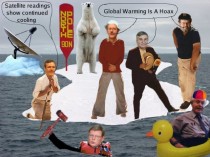
See much more here.
|









